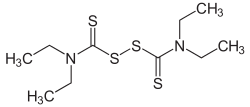Disulfiram-like drug
A disulfiram-like drug is a drug that causes an adverse reaction to alcohol leading to nausea, vomiting, flushing, dizziness, throbbing headache, chest and abdominal discomfort, and general hangover-like symptoms among others.[1][2] These effects are caused by accumulation of acetaldehyde, a major but toxic metabolite of alcohol formed by the enzyme alcohol dehydrogenase.[1][2] The reaction has been variously termed a disulfiram-like reaction, alcohol intolerance, and acetaldehyde syndrome.[3]
| Disulfiram-like drug | |
|---|---|
| Drug class | |
 Disulfiram, the prototypical drug of this class. | |
| Class identifiers | |
| Synonyms | Alcohol sensitizers; Alcohol-sensitizing agents; Alcohol-deterrent drugs; Acetaldehyde dehydrogenase inhibitors |
| Use | Alcoholism |
| Biological target | Acetaldehyde dehydrogenase, others |
| In Wikidata | |
The prototypical drug of this group is disulfiram (brand name Antabuse), which acts as an acetaldehyde dehydrogenase inhibitor, preventing the metabolism of acetaldehyde into acetic acid, and is used in the treatment of alcoholism.[1][2] A variety of other drugs cause disulfiram-like reactions upon consumption of alcohol as unintended drug interactions and side effects.[1][2] Many disulfiram-like drugs act as inhibitors of acetaldehyde dehydrogenase similarly to disulfiram. However, some do not act via inhibition of this enzyme, and instead act via other, poorly elucidated mechanisms.
Unlike acetaldehyde dehydrogenase inhibitors and other disulfiram-like drugs, alcohol dehydrogenase inhibitors such as fomepizole (brand name Antizol) inhibit the metabolism of alcohol into acetaldehyde, thereby increasing and extending the effects of alcohol and reducing its toxicity.[4] As such, they can be thought of as converses of disulfiram-like drugs.[4] Fomepizole is used medically as an antidote against methanol and ethylene glycol poisoning.[4]
List of agents
Intended
Drugs which cause disulfiram-like reactions upon ingestion of alcohol as an intended effect include:[5]
- Calcium carbimide
- Disulfiram
- Hydrogen cyanamide
Unintended
Drugs which cause disulfiram-like reactions upon ingestion of alcohol as an unintended effect include:[6][1][7]
- Abacavir
- Cephalosporins such as cefamandole, cefmenoxime, cefmetazole, cefonicid, cefoperazone, cefotetan, and latamoxef (moxalactam); thought to be due to common N-methylthiotetrazole metabolite.[8][9]
- Chloral hydrate
- Chloramphenicol
- Cotrimoxazole (trimethoprim/sulfamethoxazole)
- Etacrynic acid
- Griseofulvin
- Hydrazines such as isoniazid and procarbazine
- Ketoconazole
- Macrolide immunosuppressants such as pimecrolimus and tacrolimus
- Mepacrine (quinacrine)
- Metronidazole
- Nilutamide
- Nitrovasodilators (nitrates) such as nitroglycerin
- Nitrofurans such as furazolidone and nitrofurantoin
- Nitroimidazoles such as benznidazole, metronidazole, ornidazole, and tinidazole
- Pargyline
- Phenacetin
- Phentolamine
- Phenylbutazone
- Procarbazine
- Propranolol
- Sulfiram
- Sulfonamides
- Sulfonylureas such as chlorpropamide, glibenclamide (glyburide), and tolbutamide
- Tolazoline
Natural
Natural compounds and species which have been found to cause disulfiram-like reactions upon ingestion of alcohol include:[10][11]
- Coprine, via active metabolite 1-aminocyclopropanol; found in mushrooms such as Ampulloclitocybe clavipes (club-footed clitocybe), Coprinus atramentarius (common inkcap), and Imperator torosus (brawny bolete) among others
- Kudzu (Pueraria lobata)
- Coprinopsis atramentaria
See also
References
- John Marx; Ron Walls; Robert Hockberger (1 August 2013). Rosen's Emergency Medicine - Concepts and Clinical Practice E-Book. Elsevier Health Sciences. pp. 2398–. ISBN 978-1-4557-4987-4.
- Fraser AG (1997). "Pharmacokinetic interactions between alcohol and other drugs". Clin Pharmacokinet. 33 (2): 79–90. doi:10.2165/00003088-199733020-00001. PMID 9260032.
- Mutalik, M., & Sanghavi, D. (2014). Review of Drug Interactions: A Comprehensive Update.
- McMartin K, Jacobsen D, Hovda KE (2016). "Antidotes for poisoning by alcohols that form toxic metabolites". Br J Clin Pharmacol. 81 (3): 505–15. doi:10.1111/bcp.12824. PMC 4767193. PMID 26551875.
- Helmut K. Seitz; B. Kommerell (6 December 2012). Alcohol Related Diseases in Gastroenterology. Springer Science & Business Media. pp. 175–. ISBN 978-3-642-70048-4.
- Amitava Dasgupta (17 October 2016). Alcohol, Drugs, Genes and the Clinical Laboratory: An Overview for Healthcare and Safety Professionals. Elsevier Science. pp. 77–. ISBN 978-0-12-809334-4.
- Reginald Smart (22 November 2013). Research Advances in Alcohol and Drug Problems. Springer Science & Business Media. pp. 399–. ISBN 978-1-4613-3626-6.
- Kitson TM (1987). "The effect of cephalosporin antibiotics on alcohol metabolism: a review". Alcohol. 4 (3): 143–8. doi:10.1016/0741-8329(87)90035-8. PMID 3593530.
- Lewis R. Goldfrank (2006). Goldfrank's Toxicologic Emergencies (PDF). McGraw Hill Professional. ISBN 978-0-07-147914-1.
- Joseph F. Ammirati (1985). Poisonous Mushrooms of the Northern United States and Canada. U of Minnesota Press. pp. 131–. ISBN 978-0-8166-1407-3.
- Barry H. Rumack; David G. Spoerke (27 September 1994). Handbook of Mushroom Poisoning: Diagnosis and Treatment. CRC Press. pp. 303–. ISBN 978-0-8493-0194-0.